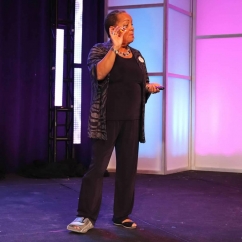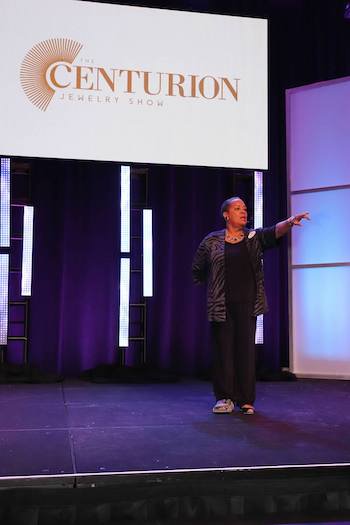Articles and News
Disney Institute Shares Strategies For Excellence With Centurion Retailers | February 05, 2020 (1 comment)

Phoenix, AZ—For three days at the Centurion Show, retailers got a glimpse behind the magic of Disney and learned how to translate some of the renowned entertainment company’s strategies to their own stores. Each morning following Centurion’s famed retailer roundtable discussions, jewelers sat down to hear Katie Sanchez, a senior facilitator at the Disney Institute, explain the attention to detail that makes the magic come alive at the various Disney theme parks and cruises. (Left: Katie Sanchez led all three morning sessions. Extra kudos to her for standing and walking on stage in an orthopedic boot!)
It all starts with culture, Sanchez emphasized over and over. “The [Disney] environment can’t be created by sending out an executive memo or directive. Our cast does what they do because of our culture.”
While Disney’s marketing is centered on the magic of the experience for customers—which it refers to as guests—Sanchez said that behind the scenes it’s not magic, it’s method. “There’s a deliberate process in how we recruit and a deliberate process of training.” The result is a more loyal, happy guest—likely to return and spend more—but also a loyal, happy cast—who are likely to make better experiences for the guests on vacation.
“It’s a formula that works well regardless of where it is: Asia, Europe, or the USA.”
As an example, she cited a little girl frightened by the noise of fireworks at the parks. A cast member playing fairytale heroine Cinderella helped the little guest, crouching down and covering her ears with her gloved hands, all the while explaining how that helped with the noise. All the little girl knew was that Cinderella helped her get over her fear of fireworks.
“We don’t have an instruction guide that says if a little guest is frightened, you put gloved hands over her ears,” said Sanchez. That’s just instinctive for a cast member who fits the culture to react.
In another instance, a cast member led a blind (adult) guest to the bust of Walt Disney and invited her to feel his face. Cast members also often will return a forgotten or lost doll or stuffed teddy bear to their young owners—but first they’ll take it around the park and take pictures of it in different places like it’s on vacation so that the child doesn’t feel like it was abandoned.
And when a cast member doesn’t quite perform in the way the Disney culture expects, that’s a coaching moment, says Sanchez. “We find out what happened and coach them. Not everybody rolls out of bed every day with pixie dust on.”
The organization recognizes that not everyone is cut out to be a Cinderella, or to work with children, or even to work directly with the public, says Sanchez. To wit, Sanchez described how when Disney’s Animal Kingdom opened, it was necessary to combine zoo culture with guest experience.
Walt Disney himself was an animal lover and conservationist, she said, and animal care and conservation is a serious business. “We blended the culture of the zoo community into the Disney community, and leveraged their love of animals. We formed a Zoo advisory board, full of zookeepers, veterinarians, and conservationists. We formed the Disney Conservation Fund, an amazing way to support conservation efforts around world and show those animal care cast members that we’re serious about it.
“They had to learn words like ‘care’ and ‘cast.’ Other Disney people had to learn words like ‘SSP, species survival plan,’.”
Over 21 years, there’s been a tangible integration of animal care and people culture, Sanchez said. Additionally, the Disney film and television division also incorporates content with conservation and environmental messaging included. “I often tell my cast that it’s cool to work for company makes world better for animals and people.”
But it wasn’t always a smooth road, she says. “We initially made on big mistake when brought in the zoo folks—we realized they were going to take care of animals but we forgot they also had to take care of people. You have to think about what is local culture and how that fits into bigger culture.”
Intentional Culture. The most important aspect of attaining the right company culture is that it’s very intentionally designed, said Sanchez.
“A lot of organizations get so caught up in doing what they do, and don’t design culture, so you have a culture of default.” That leads to what she calls a “mishmash of madness” and drives employees away. But once you have your culture established, the selection of the right people is paramount and includes a cultural immersion, which increases the probability of finding the best-fit employees.

Even though she's far from any of Disney's theme parks, Sanchez still wears her name badge with her name and hometown, same as every other cast member. She also demonstrated the "Disney point," which is always done with the whole hand, never one finger, just in case someone is in the line of sight and misinterprets it as a derogatory gesture.
If it sounds like tremendous effort, it is. “We would rather have an opportunity not filled because it’s not the right person. Other organizations say, ‘Give me a warm body, we need someone in there.’ Then you get a toxic culture because you have the wrong person there.”
She acknowledged it’s not just Disney wanting you, you have to want the Disney culture, too. If what you see—a fast-paced, diverse environment—isn’t for you, they’d rather you walk away. Even the drivers of the busses that take guests from the parking lots to the park entrances are expected to engage guests, not just drive.
Train, train, train. Training is more critical to desired behaviors and outcomes than most companies ever imagine, said Sanchez. “As soon as things get tight, training is the first thing that gets cut, and that’s a huge mistake.”
Training begins on every cast member’s first day of work and never ends. Whether they’re there for two or 22 years, every employee receives ongoing training and coaching from leaders. It begins with a session on “traditions,” even before the employee goes through HR orientation.
“Most companies start with everything you can possibly do to get fired,” she laughs. But Disney starts new hires on learning the magic first and gets to the paperwork later on. “People have even gotten through the interviews and into Traditions and then decided it’s not for them,” said Sanchez. “That’s ok, it’s self-selection.”
She also addressed a common fear of many companies: that they’ll spend money and time training someone who then leaves: “Yes, they might leave, but it’s more expensive if we don’t train them and they stay,” she replied.
Jeweler Gerry Amerosi of Gerald Peters in Staten Island, NY, asked what happens if you’ve tried and tried and someone is doing their job ok and there’s no cause to fire them but they’re just not giving that extra sparkle.
“What we have done is sit down with that person. They’re doing their job, maybe not going the extra mile, but doing the job ok. We’ll say, ‘We see some opportunities with you.’” (Sanchez cautioned that "opportunities" is a better word and not to say "challenges.")
“We often find out that they don’t like their role but we have other roles that fit them perfectly. Or sometimes someone is doing well but something changes.” She told of a cast member adjusting her costume to hide bruises. An HR manager, Sanchez pulled her aside and learned she was in a horrible abusive relationship at home. The company got her out and into a safe environment.
“When you show people you care, and it’s authentic and genuine, they stay. The extent to which you genuinely care for your people is the extent to which they will care for your customers and each other.”







